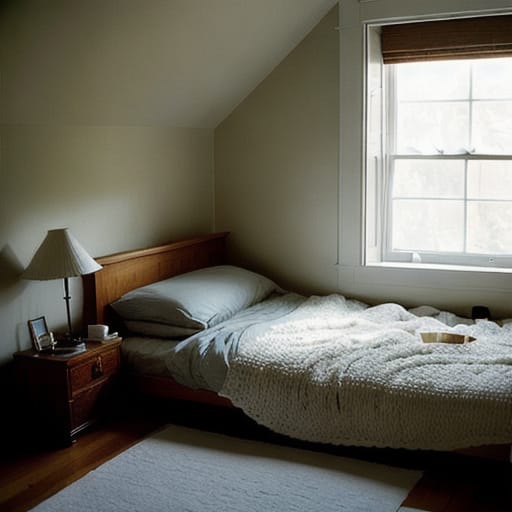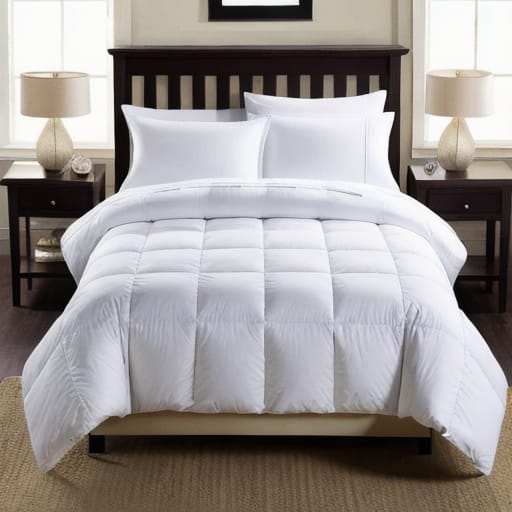Down comforters are the epitome of cozy warmth and comfort. As you sink into the fluffy layers at bedtime, little compares to the luxurious softness. But there’s nothing luxurious about being jolted awake by the dreaded musty, moldy smell coming from your bedding.
So do down comforters get moldy? The short answer is yes. Like any bedding material, down filling is at risk for developing mold and mildew if not properly cared for. Moisture combined with natural fill like feathers creates the perfect breeding ground for mold, mildew, bacteria, and dust mites.
While moldy down comforters are certainly unpleasant, they can be prevented, treated, and restored with some simple maintenance. This beginner’s guide covers everything you need to know to keep your down bedding fresh, clean, and mold-free for years of blissful sleep.
What Causes Mold and Mildew in Down Comforters
Before learning how to prevent and treat moldy down bedding, it helps to understand what causes it in the first place. The main culprit is moisture. Mold spores need a moist environment to grow and multiply. Down filling provides that ideal damp, oxygen-rich condition.
Sources of damaging moisture include:
- Night sweats
- High bedroom humidity
- Improper washing and drying
- Poor storage conditions
Additionally, lack of ventilation and air circulation allows mold colonies to thrive unabated once they take hold. Tightly packed feathers trap moisture and heat – creating a perfect petri dish for microbes!
Early Signs of Moldy Down Comforters
Catching mold issues early makes treatment much easier. Here are some telltale signs your down comforter needs attention:
- Musty, earthy smell – Usually the first indication is a distinctive moldy or mildew odor when making the bed or getting in at night.
- Discoloration or staining – You may notice darker or grayish spots where mold has started growing.
- Lumping – Wet, matted moisture-laden areas feel hardened or lumpy.
- Allergy flare ups – Wheezing, sneezing, watery eyes? Could be a reaction to mold, mildew or dust mites.
Don’t ignore these warning signs assuming it’s normal or will go away. Take action promptly before mold damage becomes severe.
Health Risks of Moldy Down Bedding
Besides being generally nasty and off-putting, moldy down comforters also pose some health hazards:
- Breathing airborne mold spores can trigger allergic reactions, asthma attacks, respiratory issues, and irritation.
- Certain types of mold release disease-causing mycotoxins. Long-term exposure poses toxicity concerns.
- Moldy bedding provides an ideal habitat for dust mites – microscopic bugs that feed on skin cells and droppings. This causes major problems for allergy and asthma sufferers.
For optimal sleep health, it’s critical to keep bedding fresh, clean, and mold-free.
Storing Down Comforters Properly
Improper storage is a leading cause of moisture damage and mold growth in down comforters. Here are some tips for safe off-season storage:
- Invest in a large breathable storage bag or chest specifically designed for bedding. These allow good airflow while keeping out dust. Popular picks are:
Breathable Storage Bags
- Never use plastic bins or garbage bags – these trap moisture and heat which breeds mold.
- Store in a dry, well-ventilated area like a closet shelf, not on the floor or in the damp basement.
- For added protection, add cedar blocks or sachets to repel insects.
- Upon removing from storage, air out the comforter outside prior to using for the first time to release any trapped moisture and freshen.
Taking these precautions will help safeguard your investment in between seasonal use.
Washing Down Comforters
Most manufacturers recommend professionally dry cleaning down comforters every year or two. But this gets pricey, uses harsh solvents, and still won’t prevent mold if underlying moisture issues exist.
Home washing 1-2 times per year is best for killing mold, removing allergens, and keeping your comforter sanitary and healthy. Carefully follow the steps below for safe DIY cleaning.
Supplies Needed
- Large capacity washing machine
- Mild liquid detergent or specialty down wash like Nikwax
- 2 extra large towels
- Tennis balls
Washing Instructions
- Check clothing tags for any special washing instructions and maximum water temperature allowed.
- Add towels to balance the load during spin.
- Use a gentle cycle, cool/warm water, and an extra rinse option.
- Add tennis balls to break up clumping during agitation.
- Use minimal detergent to prevent residue.
- After washing, check for any stains and pre-treat if needed.
- Never wash with regular bedsheets – the buckles and zippers on covers can damage delicate fabric.
Washing removes oils, body soils, dust mite allergens and kills mold and bacteria that cause staining and odors.
Drying Down Comforters
Drying is even more important than washing to prevent moisture build-up and future mold growth. Any residual dampness will quickly lead back to mildew.
Follow these steps for correct drying:
- Select low or no heat tumble dry setting.
- Throw in 2 clean tennis balls to break up and fluff.
- Reset the timer and run for the second cycle if still damp.
- For very large comforters, take them to a carwash facility and utilize the oversized commercial dryers.
- As a last resort, air dry outside completely before storage or reuse if needed. Inside air drying risks humidity and moisture issues.
Once fully dried, your revitalized fluffy comforter will be fresh, free of allergens, and ready for many nights of blissful sleep.
Should I Keep Using a Moldy Down Comforter?
If your down comforter already has a mold issue, is it still safe to keep using after cleaning? This depends on the extent of contamination.
- Small spots of surface mold can be successfully washed and dried out of down.
- Pervasive heavy mold damage on down clusters likely indicates deeper contamination of the inner filling. This poses ongoing health risks and you’ll likely keep battling repeat infestation.
In that case, it’s best to retire the comforter and upgrade to a new mold-resistant down alternative comforter.

Preventing Mold Growth In Between Cleanings
To keep your down bedding fresh in between periodic launderings:
- Use mattress and pillow protectors to shield from body sweat and oils.
- Let the comforter air out for an hour after making bed in the morning.
- Rotate comforters between 2 sets to prolong use times.
- Utilize a dehumidifier in rainy/humid climates and change settings to 40-45% maximum humidity.
- Vacuum seal in breathable storage during off seasons.
Following a thorough washing routine paired with these moisture prevention tips will help down comforters stay plush and cozy for many years.
Best Down Alternative Comforters
For those with mold allergies, or chemical sensitivities, or who want maximum laundering ease-down alternative comforters provide a cozy night’s sleep without the feather fuss.
Down Alternative Comforter Pros
- Resist mold, mildew bacteria
- Safe for allergy sufferers
- Easy to clean and dry
- Long lasting
Down Alternative Comforter Cons
- Less lofty than quality down
- Sleeps warmer than down
- Can be noisy
The Luxurie is an Amazon favorite with a light, fluffy pockets design perfect for all seasons. It avoids overheating by preventing fill clumping. Easy care since the whole comforter is machine wash and dry.
For a luxurious quality down alternative, the Pacific Coast® FeatherBEDTM comforter offers cloud-like coziness. Crafted from ultra-soft microfiber covered in 300 thread count combed cotton sateen. Convenient handles for duvet covers. Provides plush comfort ideal for those with allergies, chemical sensitivities or who want hassle-free maintenance. Proudly made in USA for 85 years. Comes with 10 Year Warranty against defects.
When to Replace a Down Comforter
With repeated cleanings, even the highest quality down comforters will show wear eventually. Some signs it’s time to replace your bedding:
- The baffle boxes are damaged causing poking and shifting.
- You regularly wash but can’t eliminate that musty smell.
- It becomes flat, deflated looking or has thinning spots.
- Allergy symptoms won’t go away even after cleaning.
Most premium down comforters provide warmth and luxury for around 10 years when well maintained.

Let’s Recap – Do Down Comforters Get Moldy?
We’ve covered a lot of key points on keeping your down comforters clean, fresh, and mold-free. Here are the takeaways:
- Yes – down comforters CAN absolutely get moldy due to moisture exposure.
- Mold spores thrive on damp natural materials like feathers and down clusters.
- Musty smells, staining, and lumping signal mold issues.
- Wash 1-2 times per year in cold water gentle cycle.
- Thoroughly dry with NO remaining moisture each time.
- Let the air out daily, use mattress covers, rotating sets to prolong use between cleanings.
- Monitor for allergy symptoms and discard if mold damage is severe.
- Alternatively, choose a down alternative comforter for maximum mold resistance and easy care.
Frequently Asked Questions
What causes mold to grow in my down comforter?
Mold growth in down comforters is most often caused by excess moisture. Sources of moisture include night sweats, highly humid environments, improper washing and drying methods that leave residual moisture, and poor ventilation while stored. Mold spores thrive when there is moisture present on natural materials like feathers and down.
How can I get mold smell out of a down comforter?
To eliminate mold smells from down comforters, it’s important to tackle the source by washing and drying thoroughly to kill the mold and mildew. Use a large capacity machine, cold water gentle cycle, dry on low heat, and avoid overfilling. You may need to repeat washing cycles with an antimicrobial detergent like Pine Sol to fully rid embedded odors. If the smell persists even after properly cleaning and drying, it likely means mold damage is severe, so you’ll need to discard and replace the comforter.
Can I save my moldy down comforter?
You may be able to save a mildly moldy comforter if you catch it early before contamination is pervasive. The first spot treats any visible mold and salt-infected areas generously. Then thoroughly machine wash using hot water, vinegar, and borax to disinfect, followed by extra rinse cycles. Tumble dry with dryer balls on low until fully dried. Repeat cleaning if musty smells linger. However, if the down filling is very clumped and you are mold sensitive, it’s best to discard and replace with a new down alternative comforter instead.
How often should you wash down comforters?
For optimal cleanliness and mold prevention, aim to wash down comforters once to twice yearly depending on usage and climate. Hot humid environments and frequent night sweats warrant more frequent washing every 6 months. Schedule a deep cleaning before off-season storage as well to rid any lingering moisture and allergens. Always check the manufacturer’s care label guidelines too. With proper drying, most premium down can withstand repeated home laundering.
What is the best alternative to feather down comforters?
For those with severe allergies, the best alternative to feather down comforters are down alternative comforters filled with hypoallergenic polyester fibers. High quality options feel remarkably similar to real goose down in terms of fluffiness, warmth, and comfort but without the allergens. They are also much easier to clean as they can withstand frequent machine washing and drying without damage. Our top pick is the baffle-box Pacific Coast® FeatherBEDTM down alternative comforter which provides hotel collection quality at home.








